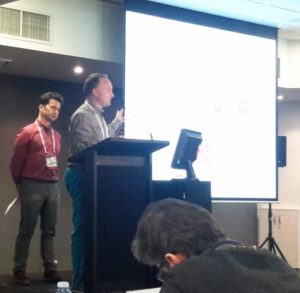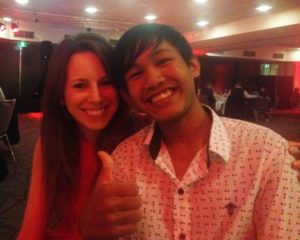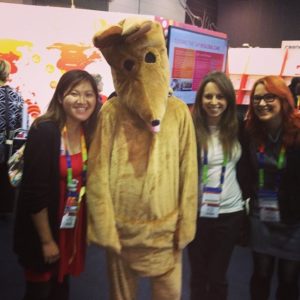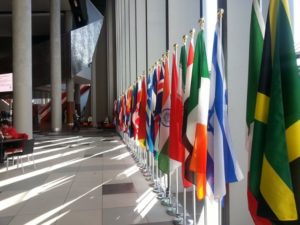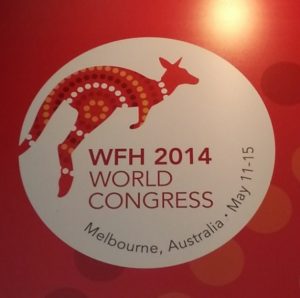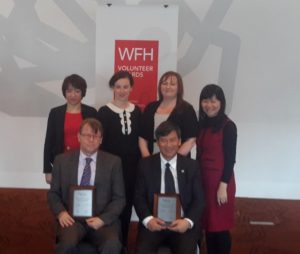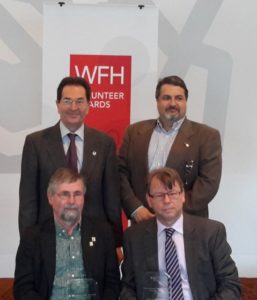Congress Diary Day 1: NMO Training
Today was the first day of Global National Member Organisation Training. People have been arriving in Melbourne at various times over the last 3 days so this was the first time the group was together. It was great to see old and new faces, although many of those faces were very tired as almost everyone is jet-lagged.
The morning started with a welcome from the WFH and an icebreaker. The icebreaker was laughter yoga and although slightly sceptical when I heard it first, it was very good and really got people to relax and settle in for a good day of work.
The morning session was a sharing of knowledge by 7 Haemophilia Organisations from Belgium, Jordan, Canada, Nepal, Philippines, Serbia and Uruguay. They discussed some of the best practices in their respective countries on topics such as advocacy, volunteering, fundraising and patient education. Our twins from Vietnam also spoke, discussing how their work has developed over the last few years. As always it is inspiring to see what others have done and a real education for me too. It is beneficial to discuss issues and problems that the organisations are facing as often other organisations have had these same issues and can offer advice.
Two of the biggest take home messages from the meeting were (1) the importance of patience and persistence and (2) that when people start to get involved in the organisation, whether it be PWH, parents, siblings or students, the whole haemophilia community benefits.
In the afternoon there were 4 workshops:
- Youth leadership which was attended by Kidlink head leader Catriona Moriarty,
- Psychosocial support,
- Pharmaceutical relations facilitated by Brian O\’Mahony and
- Data and economics session facilitated by myself.
This is the third time I have had the pleasure to facilitate a workshop for the WFH and as always I found it beneficial and rewarding. The group that I worked with today were from emerging countries and it really is a testament to the dedication of these volunteers that they can sit through me talking for more than 5 minutes, but also the level of knowledge, engagement and willingness to get stuck into any problem they possess.
The day ended for most people with Wallaby and Kangaroo sightings which is really strange as they bounce around the back of the hotel in the evening. If there was ever a reminder of where we are, that was it! However, there was not much time to enjoy the sites as our body clocks were ticking and everyone had an early night, but there is always tomorrow….
Until next time,
Declan Noone
Congress Diary Day 2: NMO Training
Today was the second day of the Global National Member Organisation training. The morning started off with a workshop on pharmaceutical relations for the established group which was facilitated by IHS CEO Brian O’Mahony. This workshop consisted of us exploring the benefits and possible consequences in accepting industry funding. We had group discussions about ethics and different types of funding. Other delegates in developing countries discussed issues or successes they have had with industry funding. This differs from country to country. From this session, I learned about some of the new treatment products that are on the market.
 All delegates aged 18 – 30 attended youth meetings during lunch. Unfortunately, Declan could not attend this as he is too old!! Part of our lunch consisted of an Australian sandwich, which to my amazement included grated carrots! Apparently we are strange for not having carrots in our sandwiches! All the youth delegates discussed ways to encourage other youths to become leaders or become more involved in the haemophilia society and also how to motivate and inspire them so they will continue to work in the society.
All delegates aged 18 – 30 attended youth meetings during lunch. Unfortunately, Declan could not attend this as he is too old!! Part of our lunch consisted of an Australian sandwich, which to my amazement included grated carrots! Apparently we are strange for not having carrots in our sandwiches! All the youth delegates discussed ways to encourage other youths to become leaders or become more involved in the haemophilia society and also how to motivate and inspire them so they will continue to work in the society.
I then attended a plenary, which for the first time the WFH congress spoke about women and bleeding disorders, it was very informative. The basics of diagnosing women with bleeding disorders, genetics counselling and treatment options were discussed. The differences in emerging and established countries were highlighted and the ways in which the organisations are trying to incorporate women were also discussed.
A session on clinical research on haemophilia was facilitated by Brian O’Mahony, Dr Van Den Berg and Dr Alok Srivastava. It was a heated discussion with opinions being voiced from many country representatives.
The day ended with a buffet dinner, following which a very talented delegate from Thailand did caricatures of the other delegates! Do you think mine looks like me?
I still haven\’t seen any kangaroos although I plan on seeing some tomorrow!
Until next time,
Catriona Moriarty
Congress Diary Day 3: NMO Training
The last day of the NMO training started today. It is great to see how the relationships within the groups have developed as there was plenty of chatter before the sessions.
Today I led a session with the established countries on data collection and health economics. For a very heavy (and to be honest quiet dull) topic for most people, everyone got engaged and there were some really good discussions. We looked at methods many governments use in order to choose reimbursing different drugs and the level of interaction was so great. I found it to be a fun session, not sure about everyone else!
In the afternoon, there was an update from WFH. This was followed by feedback from the youth committee who had examined and discussed in detail various topics such as involving youth in the organisation. Of the 100 delegates who took part in the training, more than 40 delegates made up the youth group. These are a young and dedicated group and it was so good to see this group develop over the week and find their voices. I look forward to seeing many of these talented people coming up through their national organisations and campaigning for better care in their own countries.
Work Hard – Play Hard
After 3 days of workshops and lectures, it was time to unwind. The training ended with a banquet. The training can be quite intense and with several of the delegates struggling with jet lag, I was amazed to see people were on the dancefloor before the main course had been served! I do not know where they got their energy from, I must be getting old! It was a great night and a good way to end the training.
I would like to thank the WFH for giving me the opportunity to facilitate at the Global NMO training and be part of that group.
Now on to the Congress…….
Declan Noone
Congress Diary Day 4: Opening Ceremony
As the NMO training finished up we all got to have a sleep in and recover from all the dancing at the gala dinner. Everyone was in good spirits and chatting about the previous night’s festivities although there were a few sore heads among us.
All the delegates were split up into four buses and although some of us would meet up at the congress, we still had to say a few goodbyes! I have met so many great people during the training and built great friendships.
I left Creswick with some great memories but there were more to come in Melbourne city. I was so excited to be in this beautiful city for the 31st WFH Congress. There are representatives from 128 countries at the WHF congress with 4,000 delegates expected to attend the state of the art convention and exhibition centre over the coming days.
Catriona Moriarty
_______________________________________________________________________________
The 31st World Federation of Hemophilia Congress got off to a flying start yesterday afternoon in Melbourne. After a stroll around the city, the Irish contingent gathered at the registration area of the convention centre, mingled with familiar faces, and made their way into the Opening Ceremony.
The ceremony began with a welcome from Congress President Gavin Finkelstein and WFH President Alain Weill. Two representatives from the Australian Government highlighted the importance of bringing this congress to Australia. The theme of the opening ceremony was to highlight the WFH programmes. It was lovely to hear from individuals who are directly involved with some of the programmes as it brought a personal touch to the ceremony. The sentimentality continued as a slideshow of photos, showcasing the history of the WFH, ran in the background during the ceremony.
Entertainment came in the form of a cultural experience from aborigines to the sounds of a didgeridoo.
WFH President Alain Weill closed the ceremony by leaving the audience with the following thought whether you are a scientist, a journalist, a person with a bleeding disorder, a government official or a business leader, what can you do today to increase the number of people who have access to treatment?
Before travelling to Melbourne, a meeting was held in the IHS office to discuss the Congress programme and the various sessions on offer. There are eight delegates from Ireland and the sessions have been allocated in a way that the entire programme is covered. This ensures that we have information on all areas of the programme, but it does mean that the group is scattered during the day, but we have a plan of action to ensure nobody gets lost, a dedicated meeting point in the registration area, the Girl Guide in me is coming out!
Following the opening ceremony, a reception was held and the exhibition area opened up. With various booths and over 4,000 delegates at the conference there are lots of places to go and people to see! The congress had officially started. There is a great buzz around and although there are some busy days ahead, everyone is excited for what is next, so watch this space……
Debbie Greene
Congress Diary Day 5: Ready, Steady Go!
Today was the first day of full meetings at the 2014 Congress! The conference centre is huge and walking into the foyer this morning it was a hub of activity with people locating various meeting rooms for their preferred talks – clinically focused care, genomics of bleeding disorders, management with little factor, adherence to treatment to name but a few!
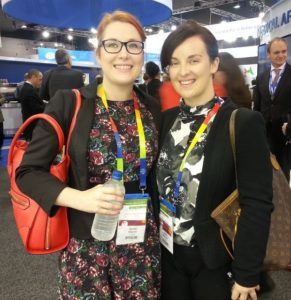 I attended Back to Basics, a musculoskeletal session with the speakers such as Professor Alison Street covering the role of the haematologist in the management of haemophilia working in conjunction with the comprehensive care team including physiotherapists, social workers and orthopaedic consultants. The next speaker Lize van Vulpen a PhD student in the Netherlands discussed blood-induced joint damage and explained how recurrent bleeds results in iron depositions which cause an inflammatory response and over time damages cartilage radial ring in osteoporosis. Next up was Nichan Zourikian, a physiotherapist from Canada who highlighted how important physiotherapy is in comprehensive care but stressed that it is important when reintroducing weight bearing exercises after a bleed to take into consideration a patient’s individual situation. Last to speak was Nicolas Goddard an orthopaedic surgeon from the Royal Free Hospital in the UK. He explained that in his hospital 50% of cases he operates on are the knee and the average age profile of his patients is 37.2 years. This talk was really interesting as he discussed the various options for patients and how undergoing a surgery to improve the range of motion in a joint or reduce pain results in a reduction in the number of bleeds annually from 5.5 to 1.2 in the affected joint.
I attended Back to Basics, a musculoskeletal session with the speakers such as Professor Alison Street covering the role of the haematologist in the management of haemophilia working in conjunction with the comprehensive care team including physiotherapists, social workers and orthopaedic consultants. The next speaker Lize van Vulpen a PhD student in the Netherlands discussed blood-induced joint damage and explained how recurrent bleeds results in iron depositions which cause an inflammatory response and over time damages cartilage radial ring in osteoporosis. Next up was Nichan Zourikian, a physiotherapist from Canada who highlighted how important physiotherapy is in comprehensive care but stressed that it is important when reintroducing weight bearing exercises after a bleed to take into consideration a patient’s individual situation. Last to speak was Nicolas Goddard an orthopaedic surgeon from the Royal Free Hospital in the UK. He explained that in his hospital 50% of cases he operates on are the knee and the average age profile of his patients is 37.2 years. This talk was really interesting as he discussed the various options for patients and how undergoing a surgery to improve the range of motion in a joint or reduce pain results in a reduction in the number of bleeds annually from 5.5 to 1.2 in the affected joint.
Next up for me was the plenary sessions with President of the WFH Alain Weill speaking on the progress and the future of the WFH which he said was based on innovation, education and advocacy. There was also some factor donations announced namely a 500 million unit donation of prolonged half-life treatment over a 5 year period by Biogen Idec and Sobi. This news was obviously warmly received by the attendees! Michael Berndt a scientist from Curtin University spoke about the role of platelets in thrombosis – this topic was very scientific so I can\’t say I understood all of the session!!!
After a quick lunch I was off to attend the session on Sharing Information with Carriers which I was really looking forward to. Dr Paula James, Haematologist from Canada was the first speaker. She discussed how bleeding in carriers of haemophilia, often with low factor levels, is still unfortunately somewhat overlooked. She mentioned how there was no standardised way of assessing the bleeding history of women. A study she is currently completing is aiming to validate a quantitative bleeding score for patients in order to provide an improved treatment and management of the symptoms of carriers. This tool is known as the Self – BAT and the ISTH BAT. The results of this study should be available in the coming year. Next up to speak was Dr Johnny Mahlangu, haematologist, South Africa, he is also currently studying the validity of the ISTH BAT and the Self BAT. Dr Mahlangu was followed by Megan from Nigeria who is a carrier and mother of two boys with haemophilia. Megan is also the Executive Director of the Nigerian Haemophilia Society. She began the talk with talking about the difficulties for carriers in Nigeria from stigmatisation affecting their careers and marriage prospects and relationships with their family and friends affected also. A huge problem in Nigeria is knowing your carrier status – it cost $ 900 to have a carrier test in Nigeria as blood tests have to be sent to the UK. Another major issue was the number of carriers who die in childbirth due to bleeding. On a more positive note Megan said the situation in Nigeria is slowly improving and the Society are providing as much education and outreach to patients as possible.
After a long day and a lot of information to process and with my brain still somewhat jet lagged, it was time for a Twinning Meeting Update with the VHA and the WFH. During the meeting Professor Tri gave a presentation on the progress made with the Twinning Programme since 2012. It was also great to see all of the improvements with the treatment centre twin with the Alfred Hospital in Melbourne and the NIBHT. Robert Leung the Programme co-ordinator for the Twinning Programme was delighted with the progress and it was agreed that both the treatment centre in Melbourne and the IHS would love to continue to work with Vietnam in the coming years!
After the twinning meeting the day was drawing to a close and it was back to the hotel! I didn\’t think it was possible to be so tired at only 6.40 in the evening but it was a very quiet night for most of us to prepare for another day at Congress!!
For now though it is goodnight from Melbourne ahead of what is sure to be another jam-packed day tomorrow!
Fiona Brennan
Congress Diary Day 6: Cultural Event
As Day 2 of the WFH congress got underway, I was still adjusting to the jet lag and was beyond tired. However, I was really looking forward to the morning session, Current Status of Haemophilia Gene Therapy.
The first speaker was Kathy High, who some members will know from speaking at the AGM earlier this year. Dr. High spoke about the remaining challenges to the widespread application of Haemophilia B gene transfer. Haemophilia B gene therapy is currently under clinical trial with many positive outcomes so far. Dr. High spoke about future directions for haemophilia B gene therapy with particular emphasis on the issue of development of new vectors for treating people with haemophilia b that have Neutralizing Antibodies to the Adeno-Associated Virus (AAV) vector.
Professor Nathwani gave the 2nd talk in which he gave detailed update on the current haemophilia B clinical trial results (10 patients maintained stable factor IX expression with follow up 17-50mths, significant reduction in factor IX usage and ABR). Prof Nathwani then discussed the approaches they have taken for gene therapy for ha patients and they have shown really positive preclinical (animal models) and hope to start phase 1/11 clinical trials in early 2015.
Trent Spenser was the 3rd speaker in this session who discussed lentiviral vectors for f8 gene therapy, which is in the late preclinical stages but hope to have vector up and running in late 2015 for human clinical trials.
Overall this session was excellent, great Q&A followed the talks and there was an enormous sense of excitement in the auditorium about these potential life changing new therapies!
After a short break and copious intake of coffee I attended 2 plenary sessions on the epidemiological aspects of inhibitor development (by Dr. Marijke van den Berg, from the Netherlands), and cellular aspects and novel approaches for tolerance (Dr. David Scott, USA). Both these talks focused on research that will lead to new and novel therapies for people with inhibitors.
After lunch I went to a session entitled Women’s Sexuality. There was 3 excellent speakers who discussed issues regarding females with bleeding disorders, particularly gynaecological problems women with bleeding disorders are faced with and how to deal with such problems.
The final session of the day I attended was again on inhibitor development. The likelihood of inhibitor development is not just genetic and there are a variety of other factors the influence inhibitor development. These non-genetic factors can be influenced and Dr. David Lillicrap discussed the animal models they have developed to help this research. The last talk in this session presented data to show that switching brands of factor VIII did not have any increased risk for developing inhibitors. The session concluded that to further extend our knowledge about inhibitors there needs to be large, international, multicentre cohort studies.
A busy day at congress was wrapped up with a cultural evening where we got to enjoy the culinary delights Australia has to offer at a taste of Australia reception. Some of Australia\’s most iconic characters made an appearance with kangaroo\’s, emu\’s and lizards bouncing around the exhibition centre while we enjoyed the food , drink and great company.
Sarah Gilgunn
Congress Diary Day 7: Nurse, Speaker, Chair and Patient
It is hard to believe that last week I was in Ireland getting things ready for the Congress and this week we are on the second last day! So much time and planning went into the event not only from the WFH and the HFA, but from us as well. At this Congress I was both a speaker and a chair at several sessions as was Brian O’Mahony and Declan Noone also spoke. It is great to attend the sessions as you gain so much knowledge, but the fact that the IHS were asked to speak shows that as an organisation we are at the forefront of haemophilia care and support services.
Day 3 of the actual Congress programme featured many sessions ranging from Women with Bleeding Disorders to Prophylaxis, von Willebrand Disease to Dental Care. As usual the Irish contingent split up so that we could attend as many sessions as possible. I attended sessions the following:
* Education and Employment Issues for People Living with a Bleeding Disorder
* With Blood in the Joint – What Happens Next?
* Haemophilia Care – Beyond the Treatment Guidelines
*Strengthening Multidisciplinary Teams to Provide Inter-Professional Care
 Seeing the first generation of ageing people with haemophilia. However, as people with haemophilia age new issues arise including cardiac issues, cholesterol etc. With these new challenges and in addition to the bleeding disorder status, new medics are introduced and there is a chance patients can fall through the cracks as different departments look after different area. It was great to see the WFH address this in these talks and some lively discussions were generated as patients, national member organisations and medics shared their views on what they see as best for the patient.
Seeing the first generation of ageing people with haemophilia. However, as people with haemophilia age new issues arise including cardiac issues, cholesterol etc. With these new challenges and in addition to the bleeding disorder status, new medics are introduced and there is a chance patients can fall through the cracks as different departments look after different area. It was great to see the WFH address this in these talks and some lively discussions were generated as patients, national member organisations and medics shared their views on what they see as best for the patient.
Following on from the success of the IHS Ageing Conference in 2013, I was delighted to be involved in the session “Embracing the Challenge of Advancing Age in Managing Haemophilia”. Ageing with haemophilia is a hot topic for national member organisations as this is the first generation with haemophilia to reach this milestone. My involvement focused on the patients and how they manage growing older with haemophilia. I was extremely pleased with how the session went, in fact if we had more time the session could have ran on as there were lots of questions.
My final session to attend was “The Power of Resilience”. As Chair of the WFH Psychosocial Committee, I found this to be both an interesting and relevant topic. Whether a person with a bleeding disorder, a parent of a child with a bleeding disorder, a partner, sibling or relative, a certain level of resilience is needed. The differences between the developing and developed countries was apparent in this session and indeed it should the different levels of resilience needed.
Later in the day it was I who had to show resilience as I ended up in the medical office when I twisted my knee! I am thankfully ok, however I have been ordered to rest up, which will be no problem as I am still quite tired, after all a lot has happened in a week. They say doctors make the worst patients, but I’m a nurse and I am following the advice and going for a rest……
Anne Duffy
Congress Diary Day 8: Awards
Today was the last day of the conference and everyone was starting to look tired after a long week of sessions, meetings and information.
Today started off with a session on new novel therapies. Dr. Oldenburg gave a rundown of all the new and adjunctive therapies that were on the way with so many new products including longer acting factor and a bi – specific antibody that can be taken instead of factors for clotting. The clever aspects that about it is that because it uses a different part of the clotting cascade to cause the blood to clot it may be very useful for patients with inhibitors.
This was followed by the last talk of the Congress on the future of prophylaxis by Dr. Caracao from the Children\’s hospital in Toronto. There are so many discussion about lower number of infusions or higher trough levels or a combination of both but essentially the future of haemophilia care will be based on tailored treatment of each individual based on their lifestyle.
In the afternoon the WFH Awards took place, where researchers, clinicians, volunteers and NMOs are recognised for their efforts over the last two years. The Haemophilia Centre Twin of 2012 was Hanoi Vietnam and Melbourne Australia. The Irish Haemophilia Society and the Vietnamese also received the Award for 2012 for Twin of the Year. It was great to see the Irish and the Vietnamese group on stage receiving the award as both organisations have worked so hard over the last few years and as we saw earlier this week, have made great progress.
Finally, the WFH Volunteer of the year award was presented to Brian O Mahony for his years of service to the WFH and is work in developed and developing countries in terms of advocacy and assistance to in procurement systems.
As we said goodbye to some of our new colleagues and friends we have met during the week who are going home, it was bittersweet, but for those who didn\’t have to leave straight away it was time to get ready for the farewell dinner. I will report in the morning on this as I think and hope it will be a late night.
Signing out
Declan Noone
Congress Diary Day 9: General Assembly
The General Assembly of the National member Organisations (NMO’s) of the WFH took place today at the end of a very successful World Federation of Hemophilia (WFH) Conference in Melbourne, Australia. The general assembly is the business meeting of the WFH where representatives from the 120 NMO’s gather to approve policy and programmes for the organisation. Likened by many to the United Nations, prior to the assembly, each NMO appoints a representative and an alternate. The representatives then take their places and vote on the various proposals, consultation with the alternate is allowed.
Similar to an AGM, there was a business meeting which saw WFH President Alain Weill and WFH CEO John E. Bournas make presentations to the NMO’s on the work carried out by the Federation since the 2012 Congress.
With the business out of the way, it was time for the elections and votes.
Among the major decisions taken by the 82 voting countries present at the 2014 General Assembly were the election of new medical and lay members to the Board of the WFH and the selection of the site for the World Conference in 2020.
Ireland may not have reached the final of the Eurovision, but we were successful in securing votes at the WFH general assembly and we were delighted that Declan Noone from the I.H.S was elected to the Board of the WFH. Declan was one of two lay candidates elected from a strong field of seven. We send him our heartiest congratulations.
The venue selected for Conference 2020 was Kuala Lumpur in Malaysia.
Although a long day, the General Assembly is a great way to end the Congress as it showcases the outstanding work carried out by the WFH in cooperation with the NMO’s, but also highlights how much work there is still to be done.
With all that said, it is time to get back to Ireland and focus on our next event, the Parents Conference. No rest for the wicked!
So until Miami 2016, it is goodbye from the Irish in Australia!
Brian O’Mahony





